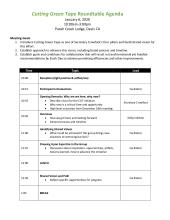- Details
-
February 12, 2020
10:00am-3:00pm
California State Railroad Museum, Sacramento CAMeeting Goals
- Introduce CGT Initiative, including process and timeline, as one of Secretary Crowfoot’s 4 pillars in partnership with other state agencies.
- Develop and identify specific recommendations, tactics, mechanisms, and next steps to advance potential actions for increasing regulatory efficiencies.
- Obtain input on the development of a white paper, to be completed by Earth Day, that identifies actionable and achievable outcomes for increasing regulatory efficiencies for natural resource stewardship.
- Details
-
Notes from the February 12, 2020 Cutting Green Tape roundtable meeting.
- Details
-
Meeting Goals
- Introduce Cutting the Green Tape as one of Secretary Crowfoot’s four pillars and build shared vision for this effort.
- Establish approach to advance this vision, including broad process and timeline.
- Establish goals and conditions for collaboration that will result in transformational yet feasible recommendations by Earth Day to achieve permitting efficiencies and other improvements.
- Details
-
January 6, 2020
10:00am-3:00pm
Putah Creek Lodge, Davis CAMeeting Goals
- Introduce Cutting Green Tape as one of Secretary Crowfoot’s four pillars and build shared vision for this effort.
- Establish approach to advance this vision, including broad process and timeline.
- Establish goals and conditions for collaboration that will result in transformational yet feasible recommendations by Earth Day to achieve permitting efficiencies and other improvements.
- Details
-
The Tahoe-Central Sierra Initiative (TCSI) is a partnership among the
USDA Forest Service, California Tahoe Conservancy, Sierra Nevada
Conservancy, The Nature Conservancy, National Forest Foundation,
California Forestry Association, and University of California Sagehen
Creek Field Station, and eight forest collaboratives. TCSI partners are
accelerating the restoration of forest and watershed resilience
through innovative planning, investment, and management across
the 2.4-million-acre landscape.This document was adapted from a product developed in 2020 for
the Sierra Nevada Conservancy for the TCSI and funded by the
California Climate Investments
- Details
-
This paper is a celebration of the many efforts the state has already undertaken to advance collaborative landscape stewardship. Innovative and forward-looking state efforts have inspired the California Landscape Stewardship Network (CA Network) to look ahead in partnership with the state, and explore ways we can work together to advance collaborative landscape scale approaches even further.
- Details
-
Invasive plants don’t see our property lines. The five partners that make up Marin County’s One Tam partnership know this, and they teamed up to create an Early Detection Rapid Response (EDRR) program tasked with identifying and managing weeds spanning the jurisdictions on Mt. Tamalpais. The EDRR team released this full report on its work from the first survey cycle, offering deep analysis of survey efforts and offering detailed strategies for addressing the mountain’s most formidable weeds. The early detection work is a cornerstone to One Tam’s efforts to protect the mountain’s iconic landscapes, and the plants and animals that call them home.
- Details
-
Sponsored and initiated by the Mammoth Lakes Trails and Public Access Foundation (MLTPA), the CALREC Vision project is working to highlight the essential, multi-benefit role that outdoor recreation plays in California. MLTPA has been engaged with local and regional issues of sustainable recreation and collaboration in California's Eastern Sierra since its inception and provides technical support to a regional public/public recreation-based solution, the Eastern Sierra Sustainable Recreation Partnership. Given its role employing collaboration to improve the social, environmental, and economic impacts of recreation in the Eastern Sierra, MLTPA invites you to visit mltpa.org to learn more about our work.
In launching the CALREC Vision Project, MLTPA engaged counsel from an array of federal, state, and regional agency and organizational experts as an Advisory Committee. Participants in the Advisory Committee generously shared their time, perspective, and advice on these topics through a series of facilitated, virtual meetings from May 2020 through July 2020. The results of those productive meetings were focused discussions and agreement about the need for cross-jurisdictional collaboration, as virtually every participant expressed encountering similar challenges. Participants also helped identify areas where collaboration can advance sustainable outdoor recreation goals within their respective agencies and organizations and throughout California.
- Details
-
December 18, 2019
10:00am-12:30pmMeeting Goals
- Share the vision for Cutting the Green Tape
- Determine shared approach for the initiative
- Establish process and confirm timeline
- Details
-
December 18, 2019
12:30pm - 4:30pmMeeting Goals
- Introduce the CDFW Better, Stronger, Faster Concept and Recommendations, including process and timeline, and link to advancing Secretary Crowfoot’s Cutting the Green Tape Initiative.
- Acknowledge the participation and contributions of all of the meeting participants in helping inspire and share the recommendations.
- Gain feedback, identify shared priorities, commitments and timeline for advancing the recommendations.
- Establish a process, approach, and conditions for collaboration that will result in achieving priorities.












